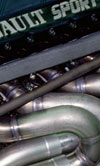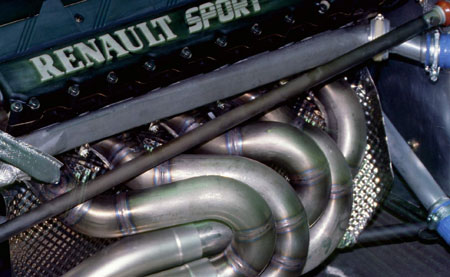Tight bends
 In previous articles, Wayne Ward looked at processes by which we might produce bends with different geometry than we can form using simple tube bending techniques, and here we briefly covered hydroforming and the manufacture of pressed bends. If we really need to cram an exhaust into a very tight space, these might offer us some advantage by allowing a very tight bend. However, we should question whether gaining this advantage comes at a cost. In some circumstances the answer to this question is 'yes'. Bends which are too tight can cause the flow to separate from the inside corner of the bend. This will cause a recirculating volume to form and therefore the results are higher local flow velocities and pressure losses. It has the same effect as introducing a local restriction in the exhaust system. This manifests itself as a greater level of 'back-pressure' at the port and can lead to a loss of engine performance.
In previous articles, Wayne Ward looked at processes by which we might produce bends with different geometry than we can form using simple tube bending techniques, and here we briefly covered hydroforming and the manufacture of pressed bends. If we really need to cram an exhaust into a very tight space, these might offer us some advantage by allowing a very tight bend. However, we should question whether gaining this advantage comes at a cost. In some circumstances the answer to this question is 'yes'. Bends which are too tight can cause the flow to separate from the inside corner of the bend. This will cause a recirculating volume to form and therefore the results are higher local flow velocities and pressure losses. It has the same effect as introducing a local restriction in the exhaust system. This manifests itself as a greater level of 'back-pressure' at the port and can lead to a loss of engine performance.
Some of the very well-funded teams and engine manufacturers take great care with exhaust design to prevent flow separation in exhaust systems, by making measurements on exhaust systems or, more commonly, undertaking computational fluid dynamics (CFD) simulations of the flow in critical areas of the system. Where taking physical measurements will determine that there is a problem, CFD can provide a visual description of the problem, showing the areas where the flow begins to separate and the volume of recirculation etc. Furthermore it is easily possible to take the same measurements as one would take physically. The early Renault V10 exhaust system may have incorporated an exhaust with excessive flow separation; now such a system would be subject to much CFD optimisation to ensure minimal separation.
So, we might ask, how tight is too tight? As with a great many questions, the answer is not a simple one. It isn't possible to specify a certain bend radius, nor a ratio of bend radius to pipe diameter. If only there existed such a magic number, our lives might become somewhat simpler. The answer to the question of what constitutes a bend that is too tight will depend on a great many variables such as flow rate, exhaust gas composition, temperature and the state of the flow upstream of the bend. Therefore the problems associated with bends which are excessively tight will perhaps only be apparent at certain engine speeds and throttle openings, although we are generally only interested in the effect at full throttle in racing engines. Certainly any performance loss at anything less than full throttle can be dealt with by opening the throttle a little more.

Without being able to specify what is too tight a bend, we can make some generalisations and the obvious one is not to use very tight bends unless absolutely necessary. Where road vehicle exhaust systems are concerned, the header pipes or primaries are generally quite similar from cylinder to cylinder, but it is often the case for single-seaters, sportscars etc that the primaries are quite different from cylinder to cylinder, and by introducing tight bends into the primary of one cylinder we can make that cylinder behave differently from the others.
Having said all of this, there are measures that can be taken and design features which can be incorporated to minimise and prevent the separation of flow in areas where bends are tight.
Fig. 1 - CFD wasn't extensively used when this exhaust system was designed
Written by Wayne Ward